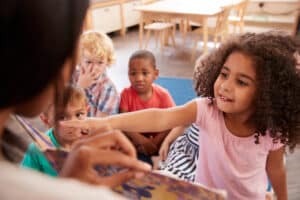
Before decoding and fluency come into play, young learners need to build a base in phonological and phonemic awareness, vocabulary, print concepts, and comprehension. Here’s what that looks like in practice:
It’s also important to remember that language development is a precursor to literacy. That’s why Launch for PreK is designed to support language development in every activity-based lesson plan across all domains, not only in literacy-based lesson plans. All lesson plans equip teachers with the Key Language vocabulary words that can be incorporated into communication supports and are also available as visual communication support cards. All lesson plans also include differentiated instruction for building language and cognitive skills.
Launch for PreK is intentionally designed to reflect what the Science of Reading tells us about how young children learn. Here’s how those principles show up across the curriculum.
Each weekly theme includes 5 Story Time lesson plans per theme, or one for each day of the week. Story Time lesson plans tap into dialogic reading, story retell, sequencing, and story recall. Teachers are guided to introduce and reinforce vocabulary systematically throughout the week, using:
View Sample: Story Time Lesson Plan
All 144 books in the Launch for PreK Children’s Library are available in multiple formats (print, digital, audio) and in English and Spanish, so you’ve got flexibility built in. The books in the PreK Children’s Library share stories that reflect the diversity of the students across the country.
In the Story Time lesson plans, teachers are guided how to systematically introduce vocabulary at the start of the week and then repeat it throughout the week. Vocabulary/key language is tied to the read aloud book and reinforced through other activity-based lesson plans.
Story Time lesson plans also include differentiated comprehension questions. Here’s an example of what this could look like in the Story Time lesson plan for the Jungle theme.
Every theme includes five Emerging Literacy lessons, one for each day of instruction. These target:
View Sample: Emerging Literacy Lesson Plan
In the Jungle theme, for example:
Notice the connection between the letter, M, the letter sound /m/, and the key language from the book, The Lion and the Mouse – Mouse, monkey, moon, mouth, and mom. All of the lesson plans are integrated and cohesive.
Language is everywhere in Launch for PreK! Vocabulary is emphasized across all activity-based lesson plans and learning domains, and visual supports are used consistently to make new words stick. In the Centers Guide and Sensory Exploration activities, we give teachers practical ways to spark rich conversations during play. For example,
All writing centers in the Centers Guide support early writing skills, and every theme includes explicit instruction in social skills to help children grow as communicators and community members.
And when students need more targeted support with language development? Language Accelerator is ready with personalized language intervention designed for both SLPs and educators to use with students who have deficits or delays in any area of language.
Learn More
Launch for PreK isn’t just aligned with the Science of Reading – it’s built on it. If you’re looking for a curriculum that blends emerging literacy, language development, whole child development, and play-based learning, it’s time to take a closer look.